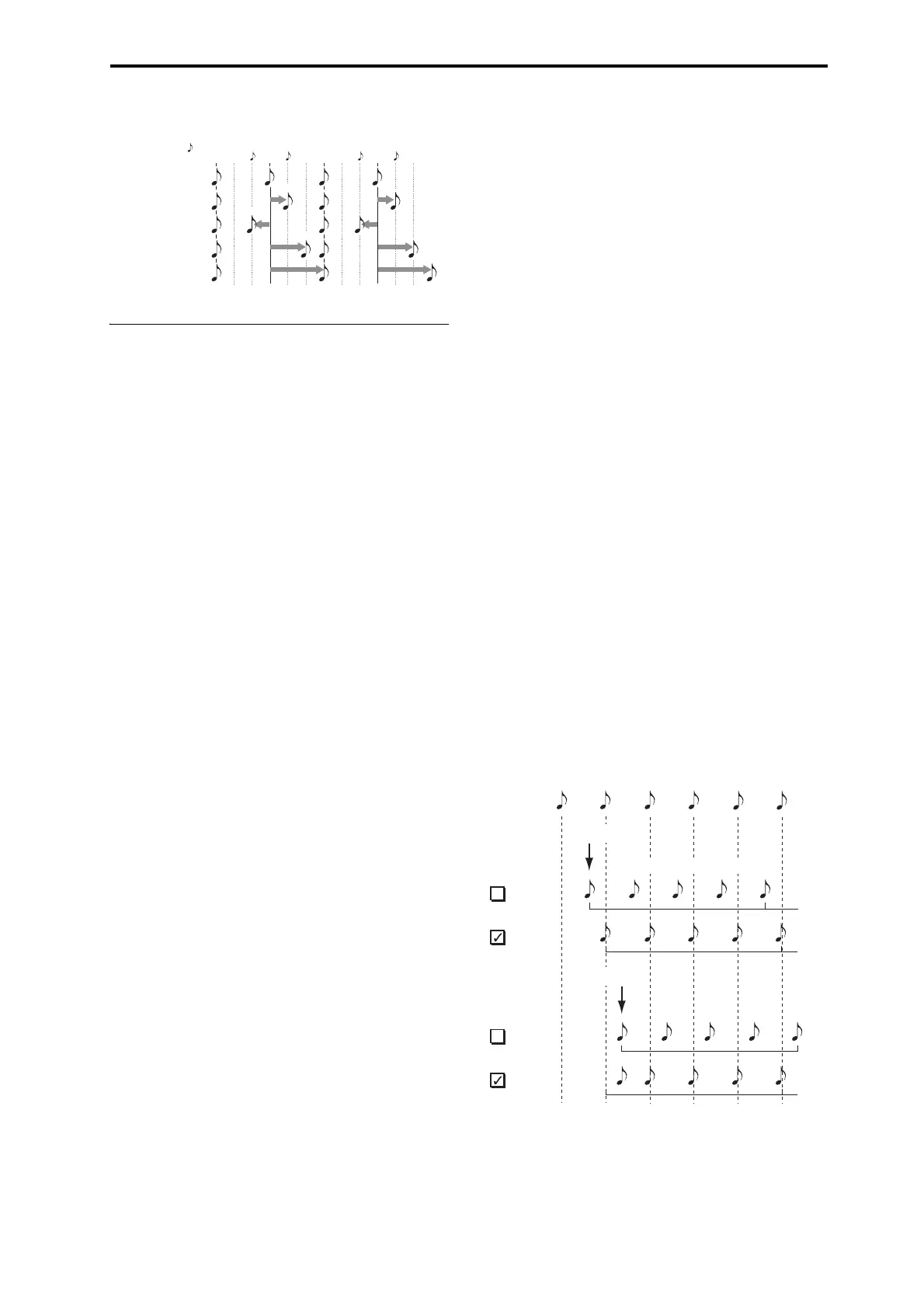Using Wave Sequences Using rhythmic Wave Sequences
189
Wave Sequence Swing
Keeping notes in sync
By default, the Wave Sequences for each note run
independently from one another, so that each note sounds as
an individual voice.
With rhythmic Wave Sequences, however, you may
sometimes want all of the Wave Sequences in a chord to start
together and sync together, in lock-step. NAUTILUS gives
you two tools to make this happen:
Key Sync Off
, and
Quantize Triggers
.
Key Sync Off
Each Program, each Combi Timbre, and each Track in a
Song has its own
Key Sync
setting. The name “Key Sync”
comes from the similar setting for LFOs, meaning “restart
separately for each note-on.”
When
Key Sync
is
On
, each note’s Wave Sequence(s) will
progress independently, so that each one can be on a
different step, or moving at a different rate.
When
Key Sync
is
Off
, on the other hand, all of the Wave
Sequences will be synchronized on the same step. There is
one exception to this, however: if Duration is modulated
with velocity or note-number, the Wave Sequences can still
progress at different rates.
To turn
Key Sync
Off
in a Program:
1. Go to the Program Basic tab of the PROGRAM >
Basic/X-Y/Controllers page.
2. Make sure that the Key Sync parameter is not
checked.
To turn
Key Sync
Off
in a Combi or Song:
1. Go to the Wave Sequence/ARP tab of the Timbre
Parameters page (for Combis), or Track Parameters
page (for Songs).
Each of the 16 Timbres or Tracks has its own
Key Sync
parameter. If you like, you can set them all separately.
2. Set the Key Sync check-boxes as you like.
Remember, to synchronize all of the notes, turn
Key
Sync
off
.
Quantize Triggers
Quantize Trigger
s allows you to force most Tempo-mode
Wave Sequence note-ons to be in sync, making it easier to
play along with other rhythmic elements.
When
Quantize Trigger
is
On
, note-ons are quantized to
8th notes using the current tempo reference. (See below for a
few more details.)
The tempo reference can come from different sources,
depending on the current mode, and whether or not ARP is
on:
• In PROGRAM and COMBINATION modes, if ARP is
off, note-ons are synchronized with the sounding Tempo-
mode Wave Sequence, if any.
• In PROGRAM and COMBINATION modes, if ARP is
on, note-ons are synchronized with ARP.
• In SEQUENCER mode during playback or recording,
note-ons are synchronized with the sequence.
• In SEQUENCER mode, while the sequencer is stopped,
note-ons are synchronized with RPPR and ARP.
Each Program, each Combi Timbre, and each Track in a
Song has its own
Quantize Triggers
setting.
To turn on
Quantize Triggers
in a Program:
1. Go to the Program Basic tab of the PROGRAM >
Basic/X-Y/Controllers page.
2. Check the Quantize Triggers box.
To turn on
Quantize Triggers
in a Combi or Song:
1. Go to the Wave Sequence/ARP tab of the Timbre
Parameters page (for Combis), or Track Parameters
page (for Songs).
Each of the 16 Timbres or Tracks has its own
Quantize
Triggers
parameter. If you like, you can set them all
separately.
2. Set the Quantize Triggers check-boxes as you like.
How Quantize Triggers works
The
Quantize Triggers
feature tries to make a good guess at
where you intended the note to be. If you play the note just a
bit late–within a 32nd note of the 8th note–it will assume
that you meant the note to sound on the beat that just passed.
In this case, the note will play immediately.
On the other hand, if you play the note up to three 32nd notes
early, it will assume that you’re intending the note to sound
on the next beat. In this case, the note-on is delayed until the
next 8th note.
Quantize Triggers
Swing Resolution =
Swing = 0%
Swing = +100%
Swing = –100%
Swing = +200%
Swing = +300%
+300%
Beat
1
Beat 2
3 3 3 3
+100%
–100
+200%
Quantize
Triggers
Quantize
Triggers
Quantize
Triggers
Quantize
Triggers
Note-On
Note-On
Wave Sequence Rhythm

